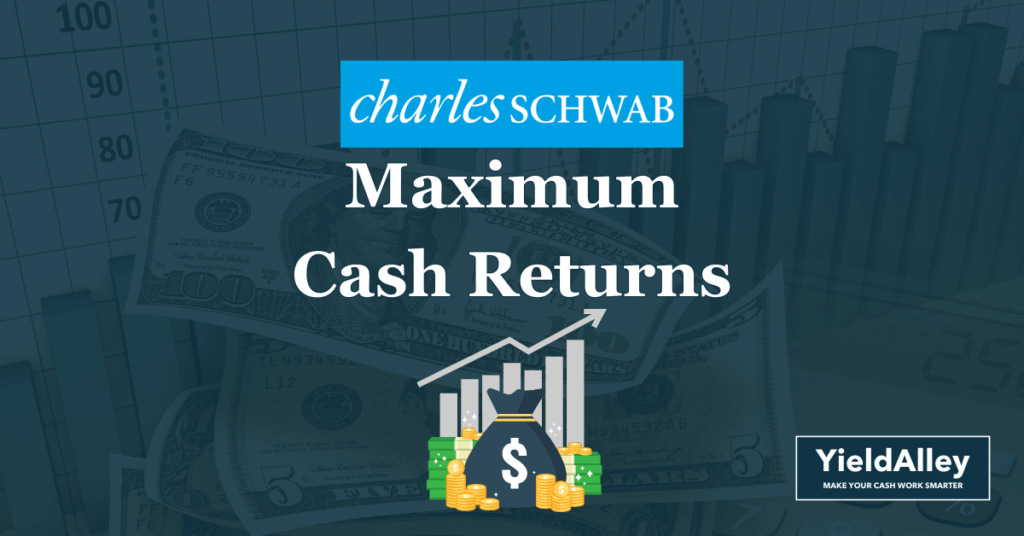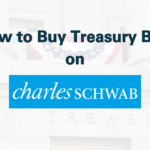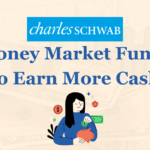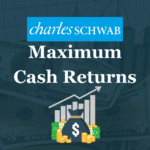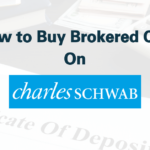This is part of our “Maximizing Cash Returns” series that teaches you how to earn the highest returns on whatever platform you hold your cash.
If you have an account with Schwab and have cash sitting around, you can easily earn returns of 5% on that cash with low-risk investments from Schwab. It’s easy and low risk, and the money you’ll make following the strategies in this guide will be far greater than anything your bank or savings account will offer. In this article, we’ll walk you through the simplest to the more complex ways to earn the highest cash returns on Schwab. We’ll start with Schwab money market funds, discuss Treasury bills and CDs, and touch on money market ETFs (also known as ultra short-term Treasury ETFs.)
Schwab Money Market Funds
Let’s first review Schwab’s money market finds. Schwab offers 3 types:
- Government & Treasury money market funds
- Prime money market funds
- Municipal money market funds
As of the time of this writing, government money market funds and prime money market funds currently pay over 5% yield per year. Municipal money market funds have yields closer to 3% and offer certain state tax benefits based on where you live.
Most Schwab money market funds don’t have a minimum investment. Schwab offers an institutional version of their money market funds targeted at investors who will invest at least $1,000,000. They’re called Ultra Shares and they’re similar to the money market funds that have no minimum investment. Schwab charges a lower expense ratio for the Ultra Shares funds.
To keep things simple in this article, we’ll only cover government money market funds and prime money market funds with no minimum investment. They offer the highest yields and highest security, which are our primary objectives.
Government Money Market Funds
Schwab has three government funds with no minimum investment:
- SNOXX, Schwab Treasury Obligations Money Fund
- SNVXX, Schwab Government Money Fund
- SNSXX, Schwab U.S. Treasury Money Fund
These funds each hold a different amount of U.S. Treasury bills, short-term debt that’s backed by U.S. Treasuries, or other U.S. government debt such as agency bonds (e.g., Fannie Mae). Treasury bills are considered the safest investments in the world because the U.S. government guarantees that it will pay back the money it borrows.
- SNOXX is Schwab’s most popular money market fund. It currently manages $35 billion dollars, and it holds U.S. Treasury bills and short-term debt backed by Treasury bills. SNOXX currently has a yield of 5.08% with a year-to-date return of 3.96%. The expense ratio is 0.35%.
- SNVXX holds agency bonds, in addition to the U.S. Treasury bills and repurchase agreements that SNOXX holds. SNVXX has a yield of 5.08% with a year-to-date return of 3.93% and an expense ratio of 0.35%.
- SNSXX is Schwab’s Treasury-only money market fund. It only holds T-Bills and is considered the safest money market fund that Schwab provides. SNSXX has a yield of 5.10%, with a year-to-date return of 3.83% and an expense ratio of 0.35%.
Prime Money Market Funds
The second money market type is the prime money market fund. Schwab only has one option with no minimum investment: SWVXX, also called the Schwab Value Advantage Money Fund.
SWVXX invests in riskier assets than the government money market funds. It still primarily holds U.S. Treasury bills and other U.S. government debt, but it’ll also hold very short-term company debt such as CDs and short-term debt from banks and financial institutions. Because these assets are riskier, SWVXX has a yield of 5.26% and year-to-date returns of 4.11%. Its expense ratio is 0.35%.
Schwab Money Market Funds vs. Other Brokerage Money Market Funds
Schwab money market funds are a simple way to earn returns on your cash. The yields are competitive with the offerings from other brokerages, and Schwab charges a lower yield than Fidelity.
However, Schwab underperforms in a few regards.
The first is that it does not offer an auto-sweep feature like Fidelity and Vanguard. Fidelity and Vanguard will automatically “sweep” any uninvested cash into one of their money market funds. With Schwab, you have to manually buy and sell each money market fund.
The second is settlement time. Fidelity treats all its money market funds as cash, so any sale of a Fidelity money market fund will instantly settle, and you’ll get cash immediately to withdraw or buy another investment. With Schwab, you have to wait for the sell trade to settle, which is usually two business days. That means you won’t have access to cash for two days, and miss out on two days’ worth of interest income or any price fluctuations for other securities you want to buy.
Finally, Schwab does offer lower expense ratios compared to Fidelity, but it’s not the lowest on the market. Vanguard’s fees are half or even a third of Schwab’s. But Vanguard has a starting minimum investment of $3,000, which Schwab and Fidelity do not have.
Our Opinion on Schwab Money Market Funds
Here is a table comparing the different Schwab money market funds.
Best viewed on the desktop for a full comparison. Data as of January 2024.
Remember, our objective is to always earn the most cash we can while keeping things simple and safe. As a result, we recommend three Schwab money market funds depending on your situation and preference.
If you want the highest yield, go with SWVXX. If you’re extremely conservative or want to take advantage of a state-tax exemption, buy SNSXX which only holds Treasury bills. Otherwise, go with SNOXX which offers a balance of having a higher yield than SNSXX and slightly more safety than SWVXX.
To learn more about Schwab money market funds, check out the following articles:
- How Schwab Money Market Funds Earn You More Simple Cash
- Schwab Government Money Market Funds Are A Safe Haven For Higher Cash Returns
- Money Market Funds: A Simple Way to Earn More Safe Cash
Treasury Bills on Schwab
You can also buy Treasury bills directly on Schwab. Treasury bills currently offer higher rates than Schwab money market funds, which themselves hold a bunch Treasury bills.
Treasury bills (also known as T-Bills) are U.S. Treasuries with a maturity of less than one year. Currently, the highest T-Bill yield is 5.49% on a 6-month maturity, and the lowest is 5.33% on a 12-month maturity.
There are no fees or expense ratios when we buy a Treasury bill on Schwab. We also benefit from state tax exemptions, which apply to all Treasuries.
There’s also a minimum investment of $1,000 to buy a Treasury bill on Schwab, unlike the money market funds which have no minimum investment.
Buying and selling T-Bills is simple when following our “How to Buy Treasury Bills on Charles Schwab” guide, where we outline the step-by-step process of how to do this from start to finish.
To learn more about Treasury bills on Schwab, check out the following articles:
- T-Bills Field Guide: Earn 5% with Treasury Bills in 2024
- How to Buy Treasury Bills on Charles Schwab
Bank CDs on Schwab (or Brokered CDs)
The third method to earn higher cash returns is to buy bank CDs on Schwab. Bank CDs sold on a brokerage are also known as brokered CDs. The same bank CD sold on Schwab will offer a higher yield than the same CD sold by the issuing bank directly, since Schwab will negotiate with the banks to offer Schwab customers a better CD rate.
The highest CD rate for a Schwab brokered CD in 2024 is 5.2% for its 3-month CD. There’s a minimum investment of $1,000.
Compare this to Chase Bank, which gives you a CD rate of 2% to 3% depending on how much you invest. The highest Chase CD rate is 5%, and it’s only reserved for customers who invest a minimum of $100,000. With the bank CDs on Schwab, there are no such restrictions.
Be aware of two things when buying a brokered CD:
- These rates are guaranteed only if held to maturity. Some of these CDs are callable, which means the bank issuing the CD can recall them early. This is typically done when rates go down, so they don’t have to pay you as much. To prevent this, buy a non-callable CD.
- Brokered CDs are liquid, meaning you can sell them on Schwab’s secondary marketplace before they mature. But Schwab’s secondary CD marketplace isn’t always super active, and you might not get the price you want to sell your CD at. But buying a bank CD on a brokerage is always better and more liquid than a bank CD at a bank that forces you to pay an early withdrawal penalty.
To learn more about Schwab brokered CDs, check out the following articles:
- What are Brokered CDs?
- Charles Schwab CD Rates in 2024
- How to Buy a CD on Charles Schwab
- Bank CDs vs. Brokered CDs
- Bank Hopping For the Best CD Rates
Ultra Short-Term Bond ETFs (Money Market ETFs) on Schwab
The last method to earn higher cash returns on Schwab is to buy money market ETFs. Also known as ultra short-term bond ETFs, these investments are newer and a bit more unknown and underappreciated compared to money market funds, Treasury bills, and CDs.
There are two main types of ultra short-term bond ETFs:
- Treasury ETFs
- Floating rate Treasury ETFs
Treasury ETFs hold very short-term Treasury bills, just like Treasury-only money market funds.
The most popular Treasury ETF is SGOV (iShares 0-3 Month Treasury Bond ETF). SGOV was introduced in 2020 and holds T-Bills with a maturity of 3 months or less. SGOV currently has a yield of 5.14% with a year-to-date return of 4.29%.
Floating rate Treasury ETFs, on the other hand, hold Treasury floating rate notes that always reflect the latest 3-month T-bill rate, which resets every week. When you hold a floating rate Treasury ETF, you’ll always earn the latest 3-month T-Bill rate. As interest rates rise, floating rate Treasury ETFs pay higher interest payments. If rates fall, the payments decrease.
Popular floating rate Treasury ETFs include USFR (WisdomTree Floating Rate Treasury Fund) and TFLO (iShares Treasury Floating Rate Bond ETF). USFR has a yield of 5.39% and a year-to-date return of 4.46%, while TFLO has a yield of 5.36% and a year-to-date return of 4.49%.
In our opinion, ultra short-term bond ETFs are a great alternative to Schwab money market funds. The yields are higher and the settlement time of T+2 (two business days) is similar. Currently, we don’t see a huge advantage that Schwab money market funds have over these ETFs.
To learn more about ultra short-term ETFs, check out the following articles:
Comparing Our Cash Returns Options on Schwab
You now understand the main ways to earn the highest cash returns on Schwab: money market funds, Treasury bills, CDs, and ETFs.
To compare your options on Schwab, we put together the table below that compares each investment’s yield, fees and costs, minimum investments, “sweep” features, and tax benefits if any.
Best viewed on the desktop for a full comparison. Data as of January 2024.
You have many options on Schwab to earn higher cash returns. We would personally go for the ultra short-term bond ETFs given they pay higher yields than Schwab money market funds and have lower expense ratios. The ETFs also have better liquidity than brokered CDs. USFR and TFLO are meant to always provide you with the latest 3-month T-Bill rate and they’re easier to buy and sell than T-Bills.
With our guide, you now have the tools to maximize your cash returns on Schwab. Don’t leave your cash in your bank or savings account! Put it to work and earn some extra income.
Interested in earning higher returns on other brokerages? Check out other articles in the ““Maximizing Cash Returns” series:
